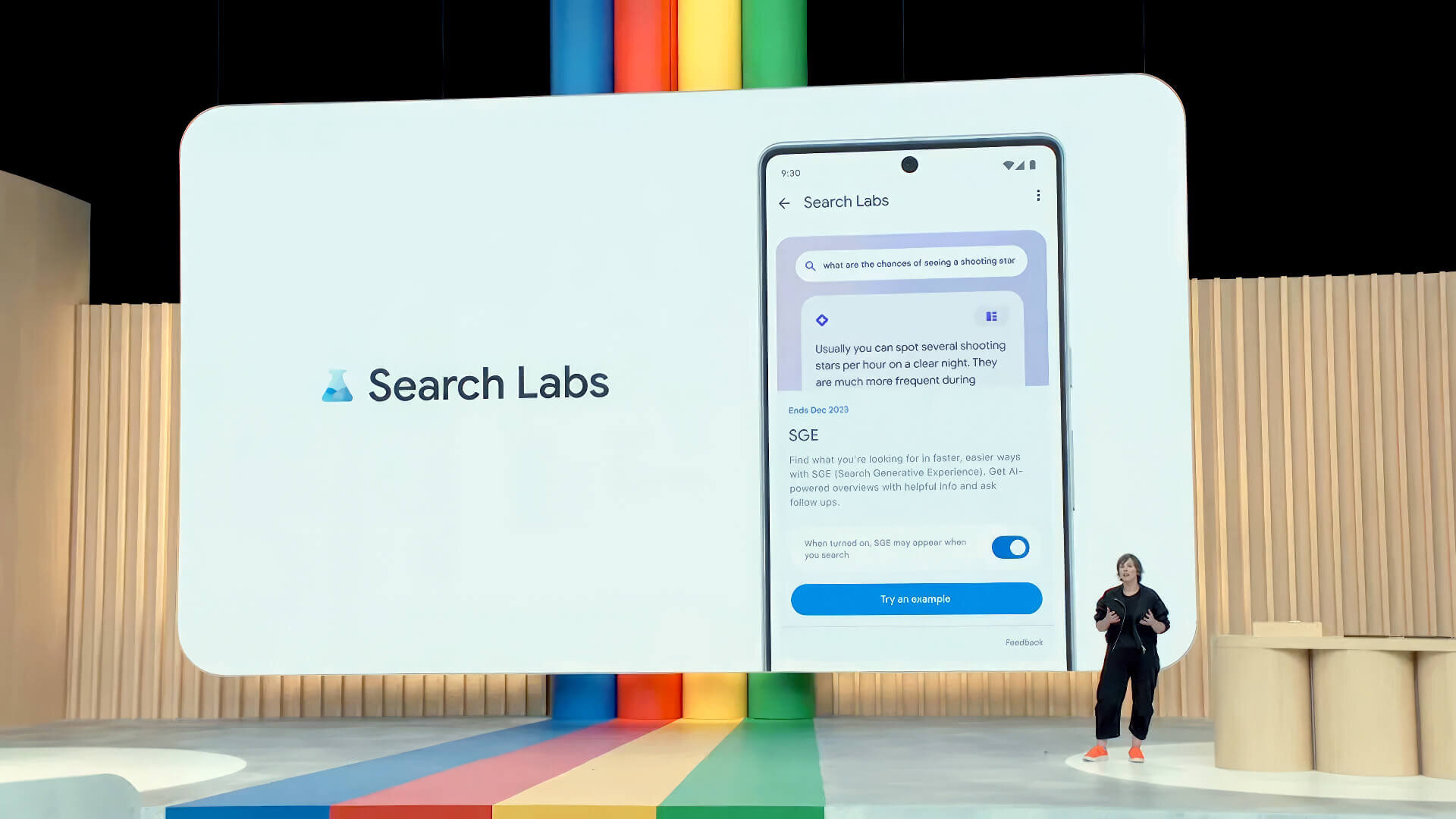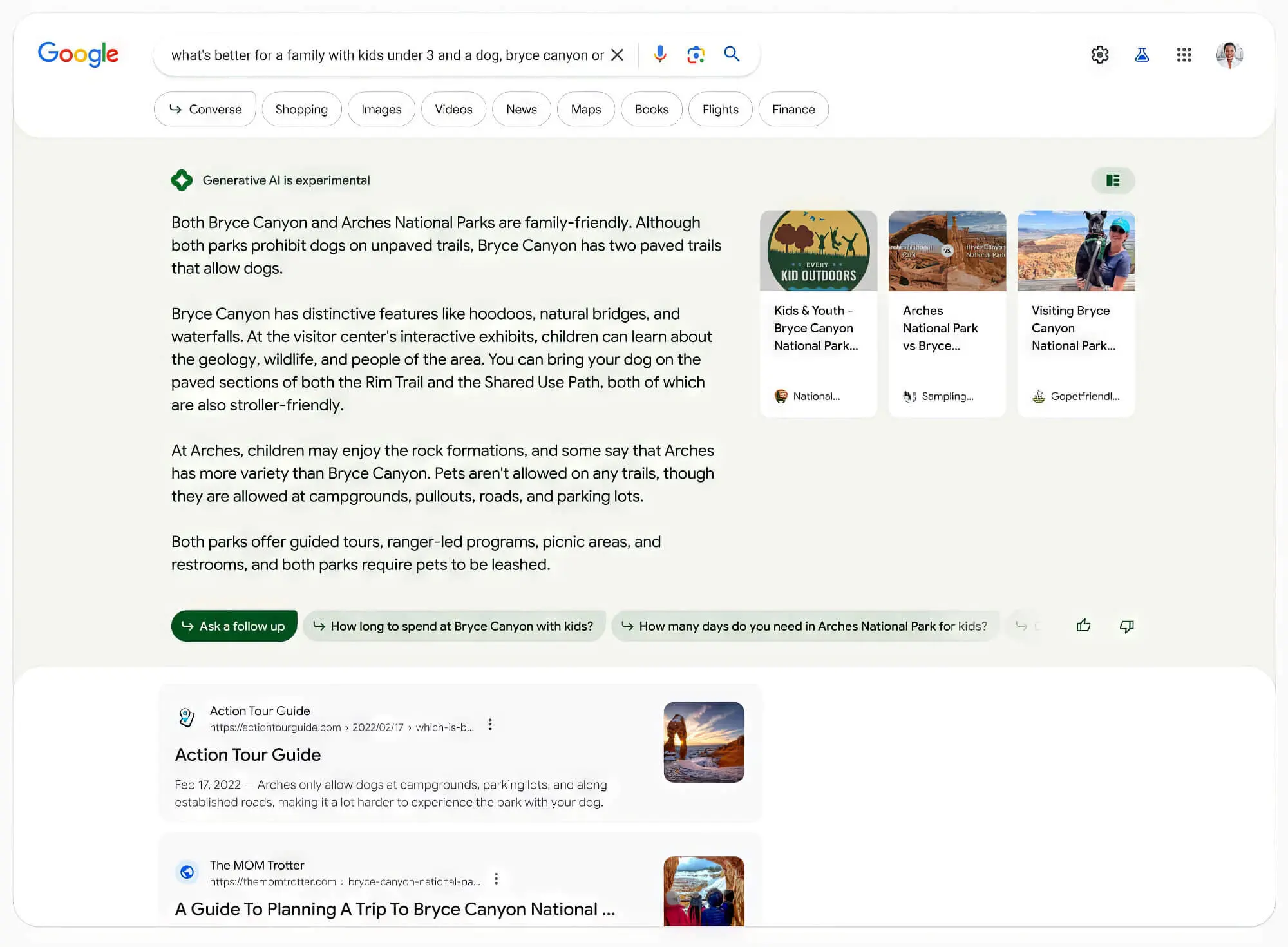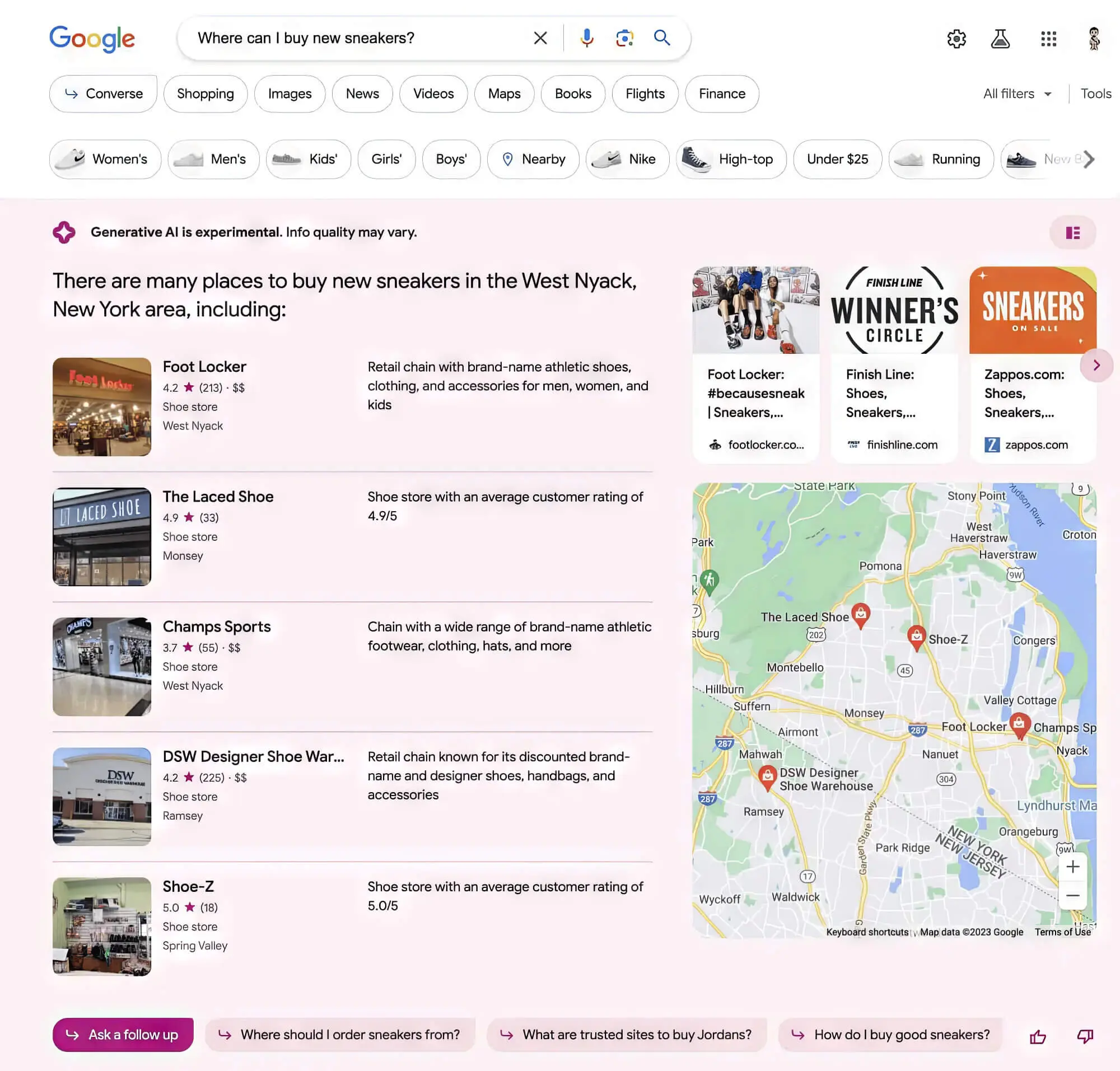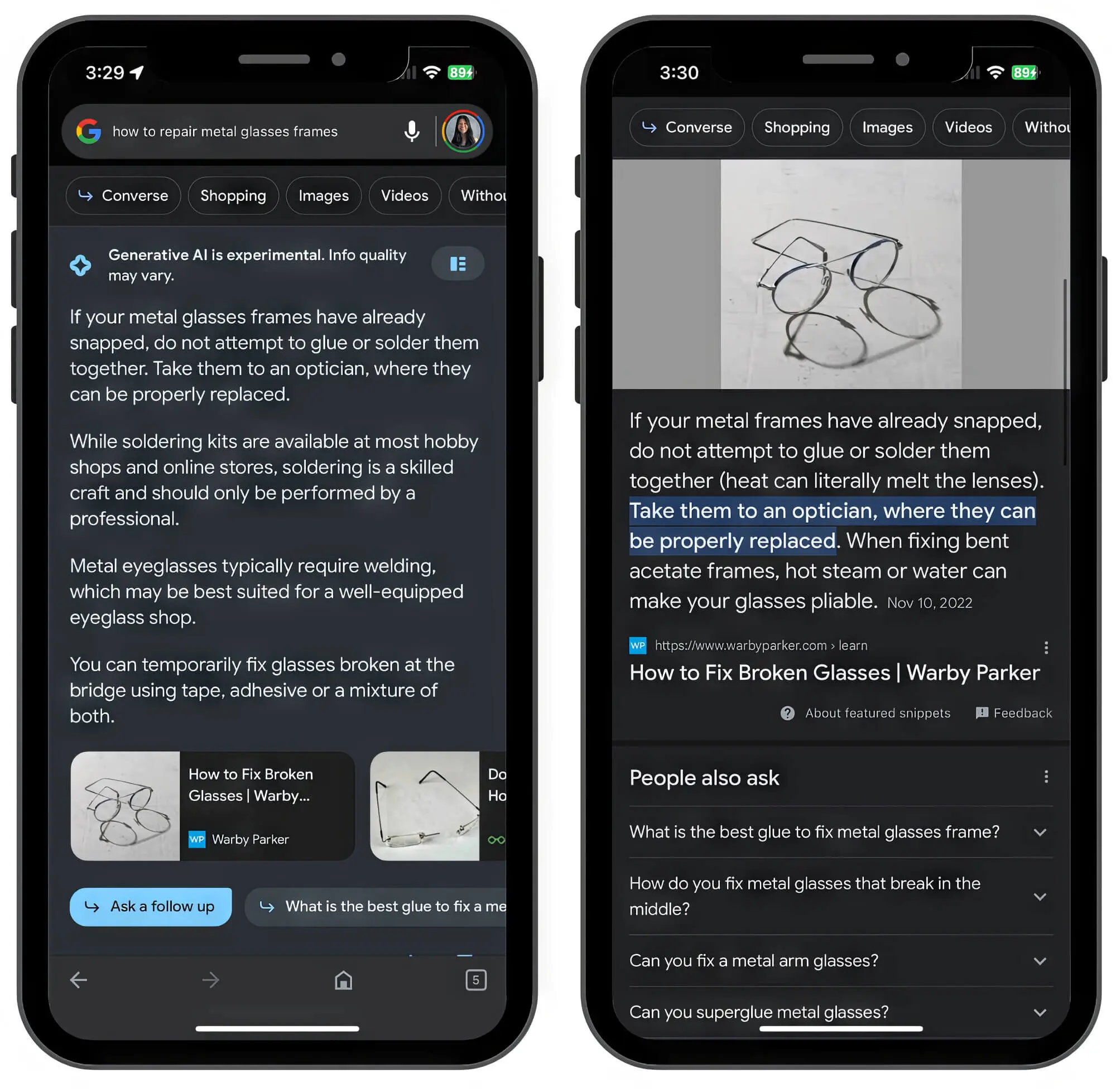Back in the early 2000s, Google made its mark with its search engine, handling millions of searches daily. It quickly became the go-to for finding information online.
Since those early days, Google’s search engine has seen a lot of changes, all aimed at boosting its capabilities and making the user experience even better.

Recently, the search giant announced the Search Generative Experience (SGE). This experimental version of the search engine uses Artificial Intelligence to provide context-based results for user queries. So, when a user types a query in the search box, Google provides the most relevant results directly instead of providing links to pages that might have the required information.
SGE is geared up to transform how info is delivered to users, making it more contextual and conversational. Businesses can also benefit from dedicated ad slots for promotions, which could impact website traffic.
Want to receive updates? Sign up to our newsletter
Each time a new blog is posted, you’ll receive a notification, it’s really that simple.
How The Google Search Generative Experience (SGE) Works
Whether you run your own company or want to learn how to make the best use of SGE as an individual, it is important to dive deeper into its workings.
Searching for information using the Google Search Generative Experience (SGE) starts like traditional searches done using the Google app. You need to type in the query or words and phrases regarding which you need information. However, how SGE answers the query varies from traditional Google searches.

In the case of a traditional Google search, the search result is provided in the form of a list of websites that appear depending on Google’s PageRank algorithms. However, with SGE, search queries are passed through the PaLM language model, which uses its new generative AI to summarise the key points that answer the query.
SGE response also includes questions and topics related to the query and allows modifying the original query without retyping it. You can ask a follow-up question, which will appear conversational and work like an AI chatbot. Besides delivering high-quality results, this mode can direct you to other resources and web content where additional information may be available.
SGE can enhance the search experience in three ways:
AI Snapshots
An AI-powered snapshot provides a unique way to gather accurate information from various sources. It gives users a concise view, so they can get the gist of things quickly.

Conversational Mode
Conversational mode allows you to ask follow-up questions using the suggested next steps in the AI-powered snapshot. You can use the original search context to seek answers to related topics.
Vertical Experiences
In the case of vertical searches, such as those for a specific product, SGE can create a summarised informational section that lists all important information. This can include product details, prices, and reviews, making it ideal for commercial searches for improving shopping experiences.
Benefits Of Using The Google Search Generative Experience (SGE)
1. Enhanced Relevance
SGE utilises advanced algorithms and AI to analyse vast amounts of data, user behaviour, and context. By continuously learning and adapting, it can understand user intent better and provide highly relevant search results. The generative AI can identify patterns and locate the most pertinent data, enhancing the search experience.
2. Real-Time Updates
Google’s Search Generative Experience (SGE) can provide the latest and most relevant information by continuously analysing and generating real-time content. It ensures up-to-date responses to search queries so users can access the most current news, trends, and insights. This makes the search experience more accurate and informative.

3. Personalised Search Results
When users search for information using SGE, it learns from those interactions and user preferences by analysing search behaviour and user data. It can understand individual interests, context, and intent and generate content that fits different users’ needs, resulting in a more personalised experience. This significantly improves the user experience and leads to greater user satisfaction.
4. Greater Efficiency
Google’s Search Generative Experience reduces the time and effort required when searching for information by providing more relevant and up-to-date data. At the same time, it personalises the search experience for different users, optimising the interactions for greater efficiency. Through contextual awareness and continuous learning abilities, SGE can ensure users get timely yet accurate responses.
Customisation Options In The Google Search Generative Experience (SGE)
1. Changing Language Preferences
Users can customise their search experience by specifying their language preferences. The system understands and processes queries in multiple languages, making it easy for users to interact in their preferred language. This can significantly enhance the search experience for multilingual users, as they can get organic results in the language they are most comfortable with.
2. Adjusting Content Filters
Another way to customise the search experience using SGE is by adjusting the content filters. You can apply specific filters to refine search results to display content that aligns with preferences, interests, or requirements. Such filters can include data ranges, content types, sources, and other criteria and help provide more focused information.

3. Providing User Feedback
While generative AI takes care of most of the heavy lifting in searches, you can customise it by providing feedback on search results. This can help it better understand user preferences and expectations. AI algorithms can then adapt and refine search results based on this feedback, resulting in more accurate and personalised responses.
4. Changing Niche Topic Preferences
With SGE, you can express niche topic preferences, indicating specific areas of interest or expertise. This lets the system prioritise content related to the niche topics in search results. Such customisation ensures you receive more targeted and relevant information within specified fields, resulting in a more tailored search experience.
Compatibility And Availability Of The Google Search Generative Experience (SGE)
Google’s Search Generative Experience (SGE) is only available in English as an experimental feature for US users. Those interested in the new search experience can sign up for Search Labs and join the waitlist. Once you’ve signed up, your search results will be accompanied by summaries from Google’s generative AI.
The Search Labs SGE is also available for mobile users with the Google app installed on their smartphones. It can be accessed on Android and iOS devices, while desktop users can access it using the Google Chrome browser.
Optimising Search Results With The Google Search Generative Experience
You can optimise search results with SGE in a few ways.
1. Improving Data Quality
Data quality is among the most essential considerations for optimising the GSE experience and improving it requires sourcing and curating high-quality datasets from reliable and diverse datasets. Relevant and comprehensive data ensures the accuracy and ability of SGE to generate valuable content.
2. Continuous Learning
Continuous learning in AI-generative search, like the Google Search Generative Experience, involves the ongoing process of updating and refining the model based on user interactions and feedback. As users engage with the system, it learns from their behaviours and preferences, improving its understanding of the context and intent.
3. Natural Language Processing
Generative AI models like SGE utilise Natural Language Processing (NLP) to comprehend and process human language effectively. Utilising NLP can help the system understand the semantics, syntax, and context of user queries through NLP, allowing it to generate more human-like responses.
4. Contextual Understanding
Contextual understanding is vital in optimising the Google Search Generative Experience, enabling the system to grasp the broader context of user queries. It can generate more relevant and personalised results by considering your search history, location, time, and intent.
Examples of AI-Generated Content In The Google Search Generative Experience (SGE)
Here are some examples of AI-generated content SGE provides when searching for different topics.
1. Local Searches
If you’re conducting a search that requires local information, such as near your location, SGE can provide highly accurate information for the purpose. For instance, typing a query in the search bar will result in SGE listing the closest options available instead of listing articles with that information. The search results concisely provide information and even include user ratings to make it easy to pick an option.
2. Ad Placements
Google’s Search Generative Experience can generate content that provides information to users and integrate Google Ads into the search results. For instance, when a user searches for a specific product or service, SGE can generate content describing that product or service and its users while showing ads for the same. This can significantly improve the shopping experience and also help businesses expand their reach.

3. Image And Video Descriptions
More than text-based information is needed in situations when you are searching for a highly complex topic. Additionally, such information may not be suitable for users with accessibility problems. SGE can incorporate image and video descriptions in the organic search results, making the topic more engaging.
For example, a video showing how a specific piece of machinery works can be a part of the generative AI responses and will be much easier to understand than text.
4. Product Recommendations
With its AI-powered overview, SGE can generate product recommendations tailored to your individual requirements. For instance, when you search for the best drawing tablet for artists, the SGE results will contain a list of drawing tablets that are most popular with artists. Furthermore, it is even possible to tweak the results by adjusting filters so it only shows options within a certain budget or with specific features.
Future Developments And Enhancements In The Google Search Generative Experience
1. More Natural And Conversational AI Responses
As AI technology continues to develop, the responses provided by SGE are expected to become more natural and conversational. This will allow users to have more engaging and informative conversations and have a better experience.
2. More Personalised And Relevant Content
By continuously learning from user data and past searches, SGE can provide even more personalised search experiences by providing highly relevant content. This can include providing personalised product recommendations, generating summaries of factual topics tailored to different knowledge levels, and more.
3. More Creative And Artistic Content
AI can be used to create more creative and artistic content, such as poems, paintings, and stories. This can allow users to explore their own creativity while making it easy to find inspiration from content created by others.
FAQs
1. How do you enable SGE on your smartphone?
Open the Google app on your smartphone while being signed into your Google account. Tap the Labs button on the top left and then tap the Get Started button. Once the SGE button appears, turn it on and agree to the terms and conditions.
2. How is SGE different from Google Bard?
While SGE is designed to replace traditional Google Search, Bard is meant to provide assistance in tasks like creative writing, generating code tips, etc. That said, both rely on AI to accomplish their objectives.
3. What is SGE’s biggest limitation currently?
As with all systems that use AI and machine learning, SGE relies on existing data to train itself. If that data is correct, it can result in the system providing false information to users, leading to better decisions.
Transform Your Search Experience with SGE
Google Search Generative Experience is the next stage in the evolution of the search engine that we have come to depend on when searching for information. It promises a paradigm shift in how information is accessed online, thanks to its ability to comprehend natural language, generate personalised content, and learn from user interactions.
As SGE evolves to become more powerful, the user experience is only expected to improve, with more seamless, efficient, and tailored interactions for users worldwide.






